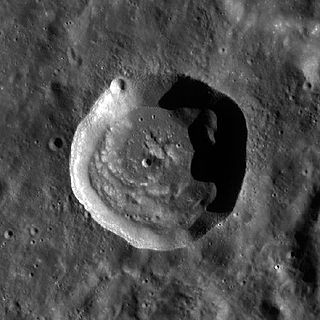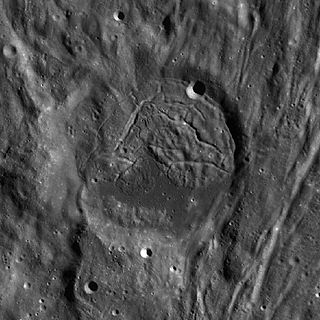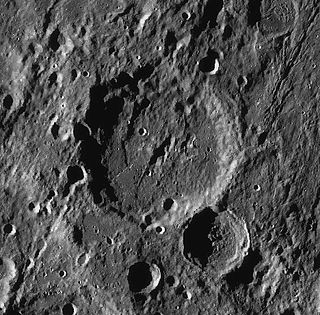 Clementine image | |
| Coordinates | 56°00′S114°54′W / 56.0°S 114.9°W Coordinates: 56°00′S114°54′W / 56.0°S 114.9°W |
|---|---|
| Diameter | 160 km |
| Depth | Unknown |
| Colongitude | 119° at sunrise |
| Eponym | Gabriel Lippmann |

Lippmann is a large lunar impact crater in the southern part of the far side of the Moon and so cannot be viewed directly from the Earth. Just to the northeast is the walled plain Mendel, only slightly smaller than Lippmann. To the south-southeast lies the crater Petzval.

Lunar craters are impact craters on Earth's Moon. The Moon's surface has many craters, almost all of which were formed by impacts.

An impact crater is an approximately circular depression in the surface of a planet, moon, or other solid body in the Solar System or elsewhere, formed by the hypervelocity impact of a smaller body. In contrast to volcanic craters, which result from explosion or internal collapse, impact craters typically have raised rims and floors that are lower in elevation than the surrounding terrain. Impact craters range from small, simple, bowl-shaped depressions to large, complex, multi-ringed impact basins. Meteor Crater is a well-known example of a small impact crater on Earth.

Earth is the third planet from the Sun and the only astronomical object known to harbor life. According to radiometric dating and other sources of evidence, Earth formed over 4.5 billion years ago. Earth's gravity interacts with other objects in space, especially the Sun and the Moon, Earth's only natural satellite. Earth orbits around the Sun in 365.26 days, a period known as an Earth year. During this time, Earth rotates about its axis about 366.26 times.
As with many lunar formations of this size, Lippmann has been eroded by subsequent impacts. The southeastern part of the rim has been overlain by the satellite crater Lippmann L, which in turn has become worn and eroded. The relatively fresh crater Lippmann Q lies across the southwest rim. The remaining rim has become worn and rounded, with a few surviving terrace-like features and the rim edge having lost their definition. The western and eastern sides of the crater in particular are nearly overlain by ejecta material.
The interior floor is relatively level, at least in the western two-thirds, but is marked by several impacts. The most notable of these is Lippmann P, located just to the southwest of the midpoint. A short chain of small craterlets lies along the southern part of the floor. The remainder is marked by a few small craterlets and pitted by tiny craters.
The terrain to the north and east of this crater are streaked with features that are radial to the huge Mare Orientale impact basin to the northeast. Also, Lippmann lies to the southwest of the Mendel-Rydberg Basin, a 630 km wide impact basin of Nectarian age (older than Orientale), and it is on the southeast margin of the Pre-Nectarian South Pole-Aitken Basin.

Mare Orientale is a lunar mare. It is located on the western border of the near side and far side of the Moon, and is difficult to see from an Earthbound perspective. Images from spacecraft have revealed it to be one of the most striking large scale lunar features, resembling a target ring bullseye.

The Mendel-Ryberg Basin is a Nectarian impact basin on the southwestern limb of the moon. It is named after the crater Mendel on the west margin and the smaller crater Rydberg north of the center of the basin. The basin is due south of the larger, younger Orientale basin, and ejecta and other geomorphological effects from the younger basin have overprinted the older one.
The Nectarian Period of the lunar geologic timescale runs from 3920 million years ago to 3850 million years ago. It is the period during which the Nectaris Basin and other major basins were formed by large impact events. Ejecta from Nectaris forms the upper part of the densely cratered terrain found in lunar highlands.






















